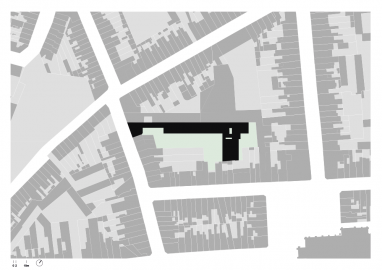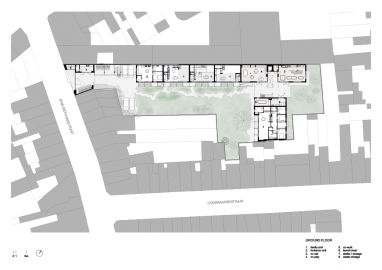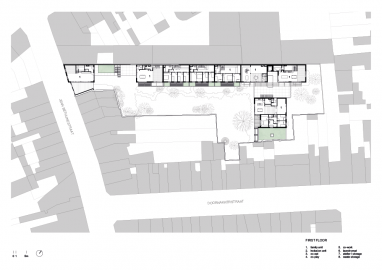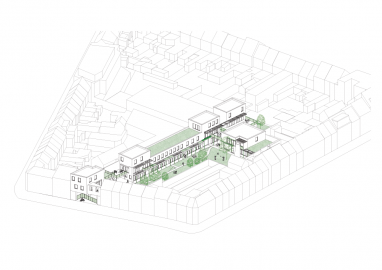Cohousing Jean
This former industrial site is now home of 10 families, looking for cohousing together. All dwellings have an equal relationship to a large garden and one is available to temporary residents in a difficult situation. The porch provides the right distance in this social togetherness. A generous opening to the street includes the public in the collective.
Cohousing Jean is located near Dampoort station, a mixed-use and working-class neighborhood in the 19thcentury urban fabric of Ghent. Within a dense building block, the project redevelops a dilapidated mushroom farm into a cohousing project consisting of 10 units – 9 family homes and 1 inclusion unit – supplemented with a variety of shared spaces and an large communal garden. The site has a relatively narrow frontage to the street, but deeper the plot folds behind the neighboring houses. The redevelopment offers opportunities for greening and thus upgrading the entire building block. By making parts of living communal, one’s own private home can be smaller. It offers an opportunity to those with lower budgets to continue living in the city. The specific conditions of the plot required a particular approach both in spatial configuration as in housing typology.
The project aspires to re-open the heart of the building block as a valuable asset for both the project and the building block. A long stretched volume flanks the northern partition wall and takes a turn at the back where the site widens. By building back-to-back to the adjacent building, a large communal garden is preserved. The relation between the private units and the outdoor areas are diverse yet equivalent. Some living rooms are on ground level adjacent to the shared garden, others are located on the first floor and can be reached via an outdoor staircase in the ‘armpit’ of the volumetry. It is here that the collective life unfolds: a communal kitchen, co-work space, laundromat and playroom are organized around a covered shared terrace. The sober volumetry is supplemented by a playful configuration of canopies which offer shade to the large south-facing windows. In addition, these ‘porches’ constitute an informal yet important threshold between the private and the collective, providing an appropriate distance between both. The street facade is elaborated as an open gate, offering a glimpse of the collective life that unfolds within the building block.
The facades are a collage of whites with alternations in materials and textures that follow a logic. The surfaces that know a lot of passage receive a certain robustness by the use of brickwork or tiles. The other surfaces have a more delicate stucco cladding and depending on their orientation, some of them have a rocky, others a brushed finish that casts shadows differently. The use of green lacquered metalwork adds a playful layer to the divers whites. The wooden joinery is colored in a butter yellow as are the wooden planks in-between. The wooden porch with its steel columns consist of a segmented sequence of closed green roofs, open pergolas or sun tents in front of the large windows, allowing daylight to enter deeply without the risk of overheating. A skylight against the partition wall illuminates the upper-floor hallways and provides additional zenithal light in the living rooms via the open staircases. A rational structure combines concrete slabs with wooden beamed ceilings which diversify spots in the living rooms. Compact units, performant insulation, air-water heat pump, BTES system, solar panels and greywater recovery makes it Nearly Energy-Zero homes.

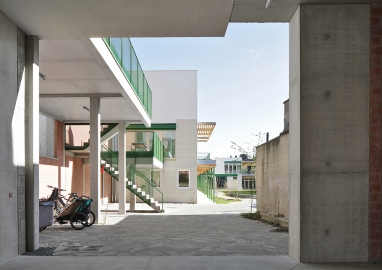 © Filip Dujardin
© Filip Dujardin
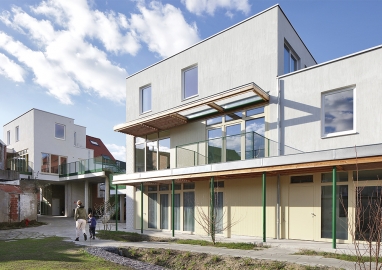 © Filip Dujardin
© Filip Dujardin
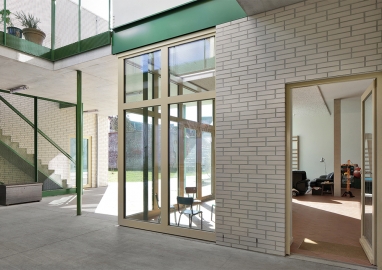 © Filip Dujardin
© Filip Dujardin
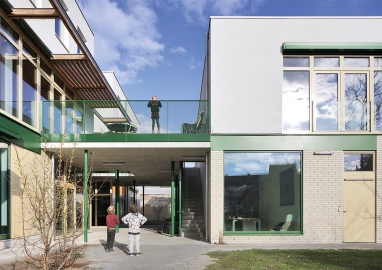 © Filip Dujardin
© Filip Dujardin
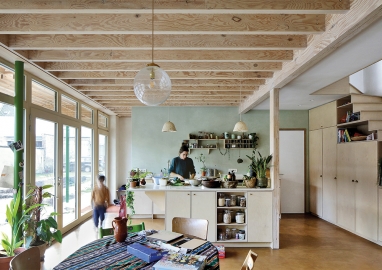 © Filip Dujardin
© Filip Dujardin
